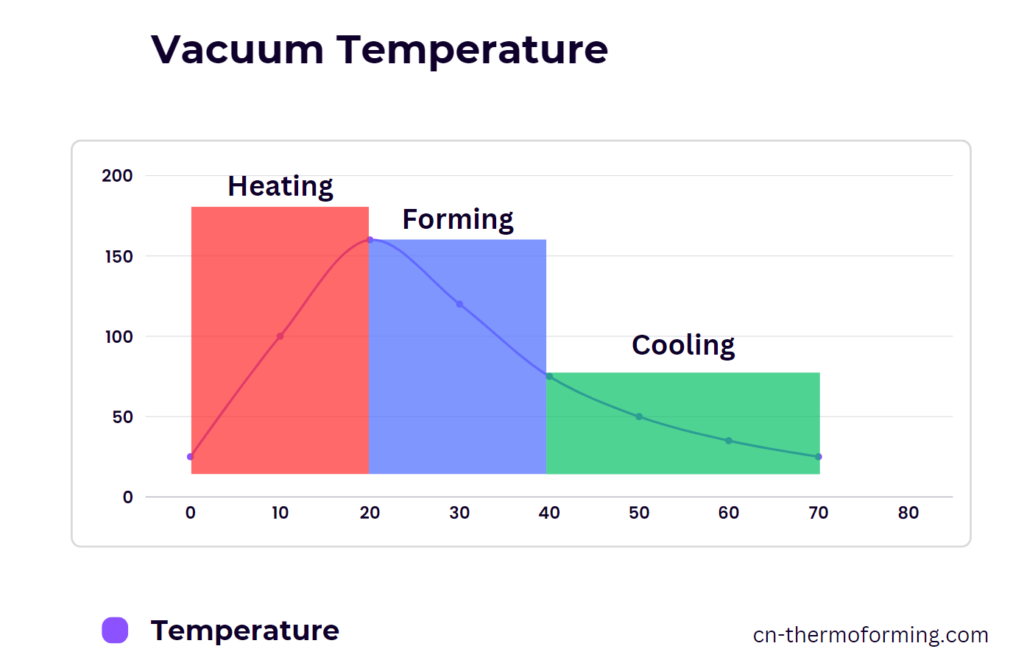Guide to Thick Sheet Vacuum Forming Machines
Introduction to Thick Sheet Vacuum Forming Machines
Thick sheet vacuum forming machines are pivotal in transforming plastic sheets (over 2mm thick) into high-quality products for industries like automotive, healthcare, and packaging. By heating, molding, and cooling plastic sheets using vacuum pressure, these machines create durable, complex-shaped items efficiently. This guide explores how they work, their applications, pros and cons, and emerging innovations.
1. Understanding Thick Sheet Vacuum Forming Machines
1.1 Key Components and Functions
A thick sheet vacuum forming machine comprises:
- Sheet Positioning System: Ensures precise alignment of plastic sheets.
- Heating System: Softens sheets to optimal forming temperatures (prevents burning or incomplete molding).
- Vacuum System: Generates negative pressure to adhere sheets to molds.
- Cooling System: Rapidly solidifies products post-molding.
- Control Panel: Allows operators to adjust temperature, vacuum strength, and cycle times.
These components work together to automate processes like heating, molding, and cooling, ensuring consistent output for mass production.
1.2 How Do Thick Sheet Vacuum Forming Machines Work?
The vacuum forming process involves six key steps:
- Loading: Place the plastic sheet on the machine’s frame.
- Heating: Radiant heaters soften the sheet uniformly.
- Forming: Vacuum pressure pulls the sheet onto the mold.
- Cooling: Fans or water jets solidify the product.
- Demolding: Compressed air releases the product from the mold.
- Trimming: Excess material is removed for a finished product.
Critical Parameters:
- Temperature Control: Prevents defects like warping or discoloration.
- Vacuum Strength: Adjust based on material thickness and mold complexity.
- Cooling Speed: Balances production speed with product integrity.

2. Top Applications of Thick Sheet Vacuum Forming Machines
2.1 Automotive Interior Manufacturing
Thick sheet vacuum forming machines produce dashboards, door panels, and seat components using ABS or PVC. Benefits include:
- Complex Shapes: Achieve ergonomic designs with precise contours.
- Cost Efficiency: Lower tooling costs vs. injection molding.
- Durability: Resistant to wear, heat, and UV exposure.
2.2 Medical Device Packaging
Ideal for sterile, tamper-proof packaging:
- Surgical Trays: Transparent PETG sheets securely hold instruments.
- Protective Casings: Shock-absorbent packaging for sensitive devices.
- Compliance: Meets FDA standards for safety and sterility.
2.3 Household Appliance Shells
Create sleek, durable exteriors for refrigerators, microwaves, and washing machines:
- Customization: Integrate vents, buttons, and logos directly into designs.
- Material Variety: Use ABS, HDPE, or recycled plastics.
2.4 Retail & Advertising
Produce eye-catching displays, signage, and reusable packaging.
3. Pros and Cons of Thick Sheet Vacuum Forming
3.1 Advantages
- Cost-Effective: Lower mold costs and material waste vs. injection molding.
- Rapid Prototyping: Quick mold adjustments for design iterations.
- Versatility: Works with foamed, composite, or printed sheets.
- Eco-Friendly: Compatible with recyclable plastics.
3.2 Challenges
- Surface Defects: Risk of flow marks, wrinkles, or uneven coloring.
- Material Limitations: Best for thermoplastics like ABS, PETG, and PVC.
- Thickness Constraints: Struggles with sheets over 6mm thick.
Solutions: Optimize heating/cooling systems, use high-precision molds, and train operators in parameter adjustments.
4. Future Trends in Thick Sheet Vacuum Forming
4.1 Technological Advancements
- Smart Automation: IoT-enabled sensors for real-time monitoring and predictive maintenance.
- Energy Efficiency: Solar-powered heating and AI-driven energy optimization.
- Advanced Materials: Bio-based and recycled plastics for sustainability.
4.2 Expanding Markets
- Aerospace: Lightweight cabin interiors and protective casings.
- Sustainable Packaging: Compostable blister packs for eco-conscious brands.
- Sports Equipment: Custom helmets, guards, and equipment shells.
4.3 Sustainability Initiatives
- Closed-Loop Systems: Recycle scrap material into new sheets.
- Green Certifications: Adopt ISO 14001 standards to reduce carbon footprints.
Conclusion
Thick sheet vacuum forming machines offer unmatched versatility for creating durable, cost-effective products across industries. By embracing automation, eco-friendly materials, and smart technology, manufacturers can stay ahead in evolving markets. Whether producing automotive parts, medical packaging, or appliance shells, this technology remains a cornerstone of modern manufacturing.
In this Article

